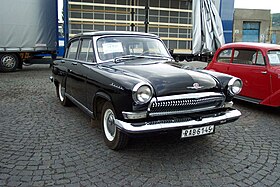GAZ Volga
| GAZ 31105 'Volga' | |
|---|---|
 |
|
| Overview | |
| Manufacturer | GAZ |
| Production | 1956–2010 |
| Body and chassis | |
| Class | Executive car (E-segment) |
| Layout | Front engine, rear-wheel drive |
| Chronology | |
| Predecessor | GAZ-M20 Pobeda |
| GAZ-21 Volga | |
|---|---|
 |
|
| Overview | |
| Production | 1956-1958 (first series) 1958-1962 (second series) 1962-1970 (third series) |
| Assembly | Gorky (Nizhny Novgorod), RSFSR |
| Designer | Lev Yeremeev |
| Body and chassis | |
| Body style | 4-door saloon/sedan 5-door estate/wagon (GAZ-22) |
| Related | GAZ-22, GAZ-23, |
| Powertrain | |
| Engine | ZMZ-21A 2.445 L I4 Small series contained a 5.52 L V8 |
| GAZ-24 Volga | |
|---|---|
 |
|
| Overview | |
| Production | 1970–1977 (first series) 1977–1985 (second series) |
| Assembly | Gorky (Nizhny Novgorod), RSFSR |
| Designer | Leonid Tsikolenko, Nikolay Kireev |
| Body and chassis | |
| Body style | 4-door saloon/sedan 5-door estate |
| Powertrain | |
| Engine |
ZMZ 24 (later ZMZ-2401) 2,445 cc (149.2 cu in) I4 ZMZ-2424 5.53 L V8 (GAZ-24-24) |
| GAZ-3102 Volga | |
|---|---|
 |
|
| Overview | |
| Production | 1982–2010 |
| Assembly | Russia: Gorky (Nizhny Novgorod) |
| Body and chassis | |
| Body style | 4-door saloon/sedan |
| Powertrain | |
| Engine | |
| GAZ-24-10 Volga | |
|---|---|
 |
|
| Overview | |
| Production | 1985–1992 (estate, from 1987) |
| Assembly | Gorky (Nizhny Novgorod), RSFSR |
| Body and chassis | |
| Body style | 4-door saloon/sedan 5-door estate/wagon (GAZ-24-12) |
| Powertrain | |
| Engine | ZMZ-402.10 (later ZMZ-4021.10) 2.445 L I4 ZMZ-505 5.53 L V8 (GAZ-24-34) |
| GAZ-31029 Volga | |
|---|---|
 |
|
| Overview | |
| Production | 1992–1997 |
| Assembly |
|
| Body and chassis | |
| Body style | 4-door saloon/sedan 5-door estate/wagon (GAZ-31022) |
| Powertrain | |
| Engine | ZMZ-402.10 2.445 L I4 ZMZ-4062.10 2.3 L I4 ZMZ-4021.10 I4 |
| GAZ-3110 Volga | |
|---|---|
 |
|
| Overview | |
| Production |
|
| Assembly |
|
| Body and chassis | |
| Body style |
|
| Powertrain | |
| Engine |
|
| GAZ-31105 Volga | |
|---|---|
 |
|
| Overview | |
| Production | 2004–2009 |
| Assembly | Russia: Nizhny Novgorod |
| Body and chassis | |
| Body style | 4-door saloon/sedan |
| Powertrain | |
| Engine | |
| GAZ-3111 Volga | |
|---|---|
 |
|
| Overview | |
| Production | 1998-2002, 2004 |
| Assembly | Russia: Nizhny Novgorod |
| Body and chassis | |
| Body style | 4-door saloon/sedan |
| Powertrain | |
| Engine |
|
Volga (Russian: Волга) is an automobile brand that originated in the Soviet Union to replace the venerated GAZ Pobeda in 1956. Modern in design, the car survived several generations. Although Volga cars were readily used as taxi cabs, road police interceptors and ambulances (based on the estate versions), it was their role in serving the Soviet nomenklatura, that made them a contemporary cultural icon. Several generations of the car have been produced.
The original GAZ-M-21 was produced between from 1956 and underwent two facelifts (1958, 1962) along with a technical modernisation in 1965 before retiring in 1970. The car marked the blossoming era of Nikita Khruschev's thaw, and despite its limited private sales, was very sought by the Soviet public, becoming a symbol of style and success.
The GAZ-24 followed, and was produced from 1968, underwent a modest facelift in 1976. The GAZ-24 was originally to be replaced by the GAZ-3101, but the latter car never reached past prototype stage. Unlike the -21, the -24's long production saw the country decay in the stagnation period of Leonid Brezhnev's rule. Its image portrayed the social inequality between the Soviet ruling class, whose privilege not only included a chauffeured Volga, but an even more rare opportunity to privately own one. Also it became a major object of speculation on the lucrative Soviet grey economy, officially not tolerated, but privately welcomed by the state.
By 1980 a replacement was developed in face of the GAZ-3102, which was based on the central platform and body of the GAZ-24, but with original fascia, interior, engine and chassis. However, political and economic stagnation of the late Brezhnev years continuously delayed the car's launch. When the first pre-production vehicles were evaluated by Party garages, the leadership was so impressed with the car, that they barred its mass production as to avoid devaluing its status by its use in taxicabs. As a result, from 1982 and all the way until 2008, the GAZ-3102 was produced in parallel with other Volgas, though in lesser smaller quantity. Originally having its own production line and many distinct features (including a novel, but ultimately unreliable stratified charge ignition), by 1997 the differences between production, trim and accessories of GAZ-3102 and latter Volga's remained only in its exterior. GAZ-3102 originally being an exclusive car for higher ranking authorities, retained its business image during the 1990s and well into the 2000s.
...
Wikipedia
